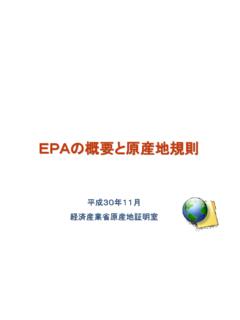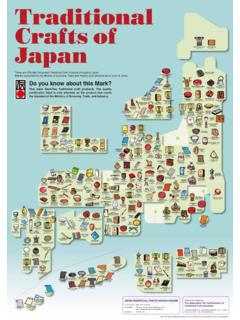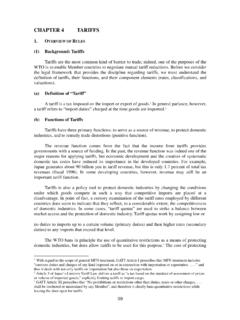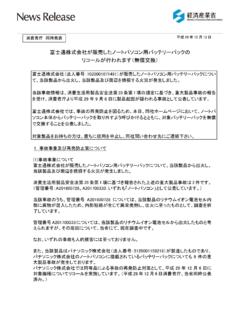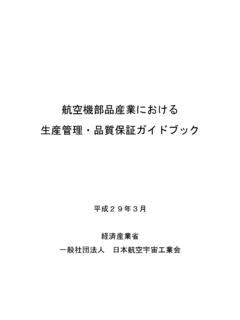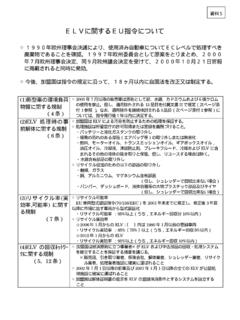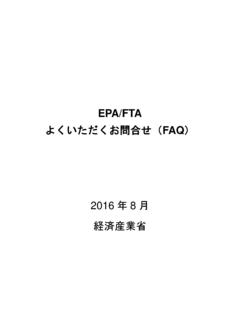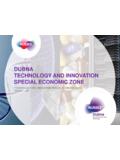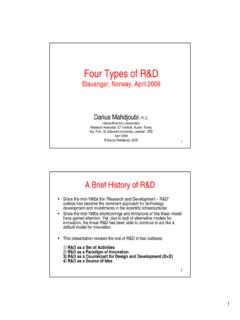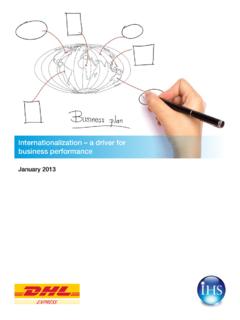Transcription of U.S. Department of Energy Advanced Reactor …
1 Department of Energy Advanced Reactor research and Development Program for Fast ReactorsJohn W. HerczegDeputy Assistant Secretary for Nuclear Technology research and DevelopmentOffice of Nuclear EnergyMarch 1, 2018 PRESENTATION OUTLINE DOE-NE MISSION AND PRIORITIES DOE-NE Advanced REACTORS PIPELINE INDUSTRIAL FAST Reactor INITIATIVES GAIN INITIATIVE SODIUM-COOLED FAST REACTORS WHY A FAST SPECTRUM TEST Reactor VERSATILE TEST Reactor DESCRIPTION TREAT UPDATE POOL vs. LOOP REACTORS METAL vs. OXIDE FUELS CONCLUSIONS2 Presidential and Departmental Nuclear Energy Priorities President Trump ordered review of nuclear Energy policy: [W]e will begin to revive and expand our nuclear Energy produces clean, renewable and emissions-free Energy . A complete review of nuclear Energy policy will help us find new ways to revitalize this crucial Energy resource. Nuclear Energy role as clean baseload power is key to environmental challenges: If you really care about this environment that we live you need to be a supporter of this amazingly clean, resilient, safe, reliable source of Energy .
2 Secretary Rick Perry at Press conference, May 10th Executive Order Promoting Energy Independence and Economic Growth Commercialization of Advanced SMRs crucial to future of US nuclear sector3 MISSION PRIORITIES42010202020302040 LWR LIFE EXTENSION (60 yrs)USED FUEL STORAGEADVANCED LWR FUELSSMALL MODULAR REACTORSADVANCED REACTORS NUCLEAR HYBRID ENERGYLWR LIFE EXTENSION (80 yrs)SUSTAINABLE FUEL CYCLEGEOLOGIC REPOSITORYTREATVTRRD&D INFRASTRUCTUREDOE-NE MISSION Advance nuclear power as a resource capable of making major contributions in meeting our Nation s Energy supply, environmental and Energy security needs Seek to resolve technical, cost, safety security, and regulatory issues through RD&D By focusing on the development of Advanced nuclear technologies, support the goals of providing domestic sources of secure Energy , reducing greenhouse gases, and enhancing national FleetAdvanced Reactor PipelineFuel Cycle InfrastructureDOE-NE MISSION AND PRIORITIESREACTOR TYPESL ight-Water Based Reactors Prismatic & pebble bed designs HeliumCooled Molten Salt CooledEmphasis.
3 TRISO fuel and Graphite qualificationLiquid Fueled Reactor (Molten Salt) Fast-,thermal-and hybrid-spectrum designsFast Spectrum Reactors See next viewgraph5Xe-100 Pebble-Bed Reactor (200 MWth)AREVA -HTGR12 X 50 MWeDOE-NE Advanced REACTORS PIPELINEINDUSTRIAL FAST Reactor INITIATIVESREACTOR , GE PRISM, ARC-100 Lead or Lead-Bismuth Westinghouse (Lead), Gen4 Energy (LBE) GA EM2 Molten TerraPowerMCFR, Elysium MCSFRHeat-Pipe Cooled OKLO, Westinghouse6GA EM2 (265 MWe) GE PRISM (840 MWth, 311 MWe))TerraPowerTWR (550 MWe)Transportable Microreactors(~5 MWth)Different Advanced Reactor Designs Being Developed By IndustryGas ReactorsGE HitachiPRISMT erraPowerTWRA dvanced Reactor Concepts LLCARC-100 Fast ReactorsMolten Salt ReactorsElysium USAMCSFRT erraPowerMCFRGA Gas-cooled Fast ReactorADVANCED Reactor EXAMPLES7 WHAT IS GAIN INITIATIVE?8 Time to market is too long Facilities needed for RD&D are expensive Capabilities at government sites have not been easily accessible Technology readiness levels vary Some innovators require assistance with regulatory processes Provide nuclear innovators and investors with single point of access into DOE complex Provide focused research opportunities and dedicated industry engagement Expand upon DOE s work with Nuclear Regulatory Commission (NRC) Private-public partnership, dedicated to accelerating innovative nuclear Energy technologies time to marketDOE recognizes the magnitude of the need, the associated sense of urgency and the benefits of a strong and agile private-public partnership in achieving the national goals.
4 What are the issues?What do we need to do?What is the DOE initiative?Gateway for Accelerated Innovation in NuclearGAIN: 9@GAIN nuclearModeling and SimulationKnowledge Management & IntegrationUnique FacilitiesModeling & SimulationCrosscutting Design SupportNRC InterfaceBase Reactor and Fuel Cycle R&D ProgramsExperimentationHPC InfrastructureVerification and ValidationM&S ExpertiseReactor physicsNuclear Hybrid EnergyNuclear Cyber SecurityDigital I&C Human FactorsLicensing FrameworkGradual Risk ReductionLicensing Support ExpertiseAdvanced Fuel CyclesAdvanced ReactorsLW-based ReactorsNuclear FuelsInstrumentation and SensorsMaterials ScienceTest Reactors GAIN Industry and investor access to DOE capabilities and nuclear innovators to DOE laboratory capabilities and RD&D programsDOE-NE FAST Reactor PROGRAM OBJECTIVES10 For fast Reactor commercial deployment, two recurring challenges are identified Capital cost Licensing framework for non-LWRs Capital cost reductionthrough application of innovative technology solutions Improved design approach components and maintenance Advanced materials Advanced Energy conversion to improve size/efficiency Advanced modeling and simulation to optimize performance Fuel development to improve fuel cycle costs Resolution of key licensing issues Safety R&D to validate tools and assure margins Qualification of fast Reactor fuels R&D Test ReactorsDATA & KNOWLEDGE MANAGEMENTTRAINING OFNEXT GENERATION OF ENGINEERS & SCIENTISTSINTERNATIONAL COLLABORATIONSWHY SODIUM FAST REACTORS?
5 And global experience with sodium-cooled fast reactors (SFR) is more mature compared to other types of fast reactors. SFR is ready for prototyping/demonstration However, it is not clear that today s design combined with today s technologies will meet the requirements for capital, operational and fuel-cycle costs. Commercial market readiness, including supply-chain and human capital, is an Breeder Reactor (EBR-II)Fast Flux Test Reactor (FFTF)WHY A TEST Reactor ? Innovative technologies are being pursued to reduce capital, operations, and fuel-cycle costs for the next generation of sodium-cooled fast reactors. Higher burnupfuels Metallic fuels without sodium bonding Materials that can sustain much higher dpa(400 dpa!!) Other fast Reactor designs being pursued by industry (lead, LBE, gas, molten salt) rely on different fuel and material types. Commercial viability and licensing requires considerably more data For sustaining long-term commercial fast Reactor operations, a test Reactor is needed for continuous technology improvements.
6 We are still conducting tests for LWR fuels and materials in test reactors. It took decades to go from 60% to 90+% availability in LWRs partly because of continuous improvements in fuels and materials. Globally, access to fast spectrum irradiation capabilities for general purposes is very limited (only exists in Russian Federation today). to Design: Conducting a 3 year research & development effort on core design. fast flux of approximately n/cm2-s, with prototypical factor: as large as possible (maximizedpa/year to > 30 dpa/year) flexibility for novel experimental capable of running loops representative of typical fast reactors (Candidate Coolants: Na, Lead, LBE, Gas, Molten Salt) May be a single location with replaceable testing height 1 to perform large number of experiments driver fuel (possible options: LEU, Pu, LEU+Pu)13 DRAFT REQUIREMENTS/ASSUMPTIONS 4OF VERSATILE TEST Reactor (VTR) PRELIMINARY VTR SIZING STUDIES143 FUEL OPTIONS FOR VTR15 FuelCompositionPeak Fast Neutron Flux n/cm2-s 300 MWVTR*Fuel Current TRLA nnual HM RequirementU-20Pu-10Zr with 5% 235U(BASELINE)~ 1015 High330 kg/y Pu and 1170 kg/y U with5% 235UU-27Pu-10Zr with depleted or natural U~ 1015 Low450 kg/y Pu and 1050 kg/y UU-10Zr with ~20% 235U~ 1015 High1500 kg/yrof U with ~20% 235U*Calculations are based assuming typical isotopic composition for Reactor grade PuTREAT UPDATE Achieved criticality on November 14, 2017.
7 Calibration and start-up testing continues Test vehicles are being developed for transient testing of multiple fuel types in the next few Over 20 GW Peak Transient Power (120 kW Steady-state power) Core: Height (4 feet); Diameter (about 6 feet); surrounded by 2 feet graphite reflector Fuel: 19 x 19 array (approximately 360 fuel elements) of 4 inch X 4 inch fuel and reflector assembliesPOOL vs. LOOP DESIGNS FOR SODIUM-COOLED FAST REACTORSLOOP DESIGNPOOL DESIGNP rimary pumps and intermediate heat exchanges are outside the vesselPrimary pumps and intermediate heat exchanges are inside the vesselMore compact design with potential cost savingsLarger vessel Potential Safety Benefits: Higher sodium thermal inertia smoother response to transients No vesselpenetrations No LOCA as a result of a leak Radioactive materials confinement Decay heat removal reliability17 Based on previous experience, prefers the the pool design.
8 However, either design can be made to work with equivalent safety by proper engineering vs. METALLIC FUELS FOR SODIUM-COOLED FAST REACTORS has considerable experience with both metallic alloy and mixed oxide fuels for SFRs Both fuel types can meet the safety and performance requirements prefers metallic alloy fuels for additional operational and safety margins based on: Extensive data collected in EBR-II, FFTF and TREAT Preferred behavior during clad breach and fuel dispersal experiments conducted in TREAT Metallic fuel behavior and negative reactivity feedback during unprotected accidents Loss-of-flow Loss-of heat sink Metallic fuel + electro-chemical processing for closing the fuel Reactor Fuel TypeFresh Fuel PropertiesMetalU-20Pu-10 ZrOxideUO2-20 PuO2 Heavy Metal Density, Temperature, K13503000 Thermal Conductivity, W/cm- Centerline Temperatureat 40 kW/m, K, and (T/Tmelt)1060( )2360( )
9 Fuel-Cladding Solidus, K10001675 Thermal Expansion, 1/ K17E-612E-6 Heat Capacity, J/g Experience, CountryUS, UKRUS, FR, JAPUS, UKResearch & Testing, CountryUS, JAP, ROK,CHIRUS, FR, JAP,US, CHICONCLUSIONS Through private-public partnerships, the is exploring the possibility of rapidly deploying demonstration/prototype Advanced reactors The pace depends on availability of private and public investments, customers (utilities) interest, and overcoming the financial and licensing risks The decision on the type of demonstration/prototype Reactor must be based on commercial viability and guided by private sector and customers. Commercial viability depends on Capital, operational and fuel cycle cost Passive safety features and ease of operations Supply-chain and human capital availability DOE-NE programs are supporting multiple design options through the ongoing R&D programs. In parallel, DOE-NE is also investing in the R&D infrastructures (with emphasis on the test Reactor ) to assure a sustainable fast- Reactor industry in the long-run.
10 TREAT already restarted Versatile Test Reactor (VTR) targeted for availability by 202619 Back Up SlideNuclear Energy Advisory CommitteeDeputy Assistant Secretary for Nuclear Infrastructure ProgramsDeputy Assistant Secretary for Nuclear Technology research and Development Manager, Idaho Operation OfficeDeputy Assistant Secretary for International Nuclear Energy Policy and CooperationDeputy Assistant Secretary for Spent Fuel & Waste DispositionDeputy Assistant Secretary for Nuclear Energy Innovation and ApplicationChief Operating OfficerAssistant Secretary for Nuclear EnergyActing Assistant SecretaryPrincipal Deputy Assistant SecretaryAssociate Principal Deputy Assistant SecretaryCentral Technical Authority/Chief of Nuclear SafetySenior AdvisorsChief of StaffChief Technology OfficerOffice of Nuclear Facilities ManagementOffice of Nuclear Materials Production, Management & ProtectionOffice of Advanced Fuels TechnologiesOffice of Advanced Reactor TechnologiesOffice of Materials and Chemical TechnologiesOffice of Accelerated Innovation in Nuclear EnergyOffice of Nuclear Energy ApplicationOffice of Bilateral, Multilateral and Commercial CooperationOffice of International Nuclear SafetyOffice of Spent Fuel and Waste Science and TechnologyOffice of Integrated Waste ManagementOffice of Program OperationsOffice of Budget & PlanningOffice of Human Capital & Business ServicesNE-3NE-4NE-5NE-6NE-7NE-8NE-1/2NE ORGANIZATION
